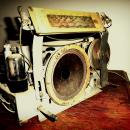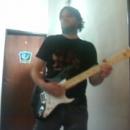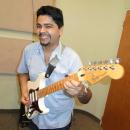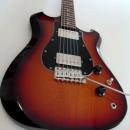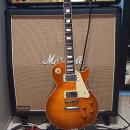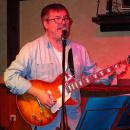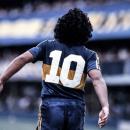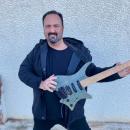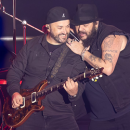en la página de EHX hay una sección llamada effectology
ahí se dedican a emular los sonidos de músicos utilizando unicamente pedales EHX
me parece que ECHOES es una de las emuladas
sino lo único que tienes que hacer es poner en google Gilmour Rig
seguro que encuentras algo, com oesto:
Effects
y aquí tienes una entrevista
A look behind DAVID GILMOUR'S mighty wall of sound.
[interview with Phil Taylor]
"I've been working with David Gilmour for over 20 years and we've exchanged very few cross words during that time," says guitar tech Phil Taylor. "David is very easygoing, but he expects things to be right -- and he is used to them being right." With his soft voice and thoughtful expression, Taylor seems more like a gentleman's gentleman than your typical rock technician. But his efficient, no-nonsense manner makes it clear why he has remained a valued member of the Pink Floyd camp for two decades. "I'm actually Pink Floyd's only full-time technician," Taylor continues. "In addition to maintaining Dave's equipment on the road, I designed and maintain his recording studio."
Clearly the elegant Mr. Taylor is eminently qualified to answer a question that tears at the hearts amd minds of millions of guitarists: How does the wizard of Floyd achieve his singing sound?
GUITAR WORLD: What is the concept behind David's road and studio systems?
PHIL TAYLOR: He likes to start with a very clean, undistorted guitar sound. All distortion, delays, compression, choruses and so on are added via various effect pedals. He applies the same philosophy in the recording studio.
GW: What does Dave use in the studio to achieve his sound?
PT: For amplification he uses a pair of Seventies 50-watt Hiwatt combos, a pair of '59 re-issue Fender Bassmans, and a Maestro Rover revolving speaker. Every once in a while he'll experiment with different guitars, but his primary instrument for the last 10 years has been his red 1984 '57 reissue Fender Stratocaster, which he also uses on the road.
GW: Is the Strat customized in any way?
PT: Yes. It's fitted with EMG-SA active single-coil pickups, an EMG-SPC midrange controller and an EMG-EXG expander which boosts treble and bass. Additionally, the guitar features a cut-down tremolo arm.
GW: What about microphones?
PT: It varies, but primarily Neumann U-87's and Shure SM-57's. We've also used a Neumann KM-86 on his rotating speaker.
GW: I notice David tends to use stomp boxes instead of rack-mounted effects. What is his reasoning?
PT: I think his general feeling is that while rack effects tend to cover a lot of areas, they don't cover any of them particularly well. He feels that foot pedals such as a Big Muff tend to have more character.
GW: How does he control his plethora of pedals on stage?
PT: He has a rack system, designed by Pete Cornish, which features a routing system of 24 sends and returns. The effects are controlled by a Bob Bradshaw pedalboard that turns them on and off in various preset configurations.
GW: What is David's workhorse amp on the road?
PT: As I mentioned, he likes his initial signal to be very clean. To achieve this he uses a mid-Seventies Alembic F2-B bass preamp and the power stage of six 100-watt Hiwatt heads. The Alembic F2-B is a very straightforward unit -- it has a bright switch, volume, bass, middle and treble controls. We, however, have altered it just a little bit. We put an extra tube in the preamp secton to give it a little more drive, lowered the impedance in the output and changed the capacitor in the bottom end to eliminate some of the lows, because it was very boomy through closed-back cabinets.
His stage speaker system consists of two WEM 4x12's with Fane Crescendo speakers, two Marshall 4x12's and three custom-made rotating speaker cabinets we call "doppolas."
GW: How did you stumble upon the Alembic preamp? It seems a strange choice.
PT: We bought a bunch of them back in the early Seventies for Roger Waters's bass system. One day we decided to use one to power Dave's Yamaha RA-200 revolving speaker system, and discovered that the amp just generated a nice warm tone. It shouldn't really be a surprise -- it basically uses a Fender circuit.
GW: Does David operate all of his effect changes from the stage, or do you control them from backstage?
PT: Dave performs all of his effects in real time. He likes to have control in case something is not sounding right on stage. It allows him to swap effects and improvise, depending on his mood. He has a very good ear, and is continually changing his effects to get the sound that he wants for any given show.
GW: What are some of the more exotic effects built into his rack?
PT: You remember the old Univox Uni-Vibes? I had one built into a rack system. We even had the old logo embossed on the face plate. We also have an old MXR DDL digital delay unit built into a rack unit. It has a digital readout, but it's really nowhere close to being accurate. Dave likes it because even though it's a digital unit, it still sounds a little dirty, like a tape unit.
He also uses a Lexicon PCM-70 to store the circular delay sounds you hear in songs like "Shine On" and "Time." Because it has a multi-tap function, it can pretty accurately duplicate the kind of echo Dave used to get from his old Binson echo unit. A t.c. electronic 2290 is his primary delay -- it's what he uses for most things.
Additional pedals include a Boss CS-2 Sustainer, MXR Dyna Comp, Iba- nez CP9 Compressor-Limiter, Boss Hyperfuzz, Electro-Harmonix Big Muff, two Chandler Industries Tube Drivers and three Boss Graphic Equalizers. He also operates several master volume pedals: one for his 4x12 cabinets, another one for his rotating speakers, another for his voice box and a speed control for the doppolas.
GW: How does Dave achieve the classic sound that we hear on the solos of songs like "Comfortably Numb"?
PT: It think it's just pretty much him. He is obviously using a couple of effects, like a Big Muff and a delay, but it really is just his fingers, his vibrato, his choice of notes and how he sets his effects. I find it extraordinary when people think they can copy his sound by duplicating his gear. In reality, no matter how well you duplicate the equipment, you will never be able to duplicate the personality.
GW: Has he ever used a locking tremolo system on his guitar?
PT: We tried using a Kahler locking system when they first came out. We liked it for a couple of weeks until we realized it completely deadened the sound. David's not really a violent whammy bar user anyway, so we really didn't need that kind of system.
GW: How many guitars does he use during the course of a performance?
PT: About seven. In addition to his Strats, he uses a Telecaster tuned to a drop-D for "Run Like Hell," two mid-Eighties Gibson J-200 acoustics -- one tuned to standard pitch and the other tuned to D,A,D,G,A,D for "Poles Apart" -- a Chet Atkins electric-acoustic and two lap steels.
GW: What kind of strings does David use on his Strat?
PT: He uses a customized set of GHS Boomers. The gauges are .010, .012, .016, .028, .038 and .048. For his acoustic guitars he uses Ernie Ball Earthwood light gauge strings.


